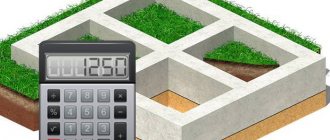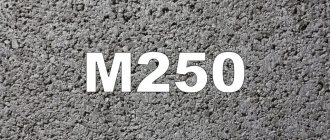The service life and strength characteristics of construction projects are determined by the quality of the concrete solution. Depending on the area of application and the tasks assigned, various types of concrete mixtures are used in the construction industry, differing in performance properties and markings. The design documentation indicates which brand of mixture should be used. Today, B15 concrete is in demand, which is indispensable in the construction of foundations, erecting walls and pouring screeds. Let's take a closer look at this building material, which has many advantages.
Foundation filled with B15 solution
Concrete grade B15 – composition
When using concrete mixtures, it is important to be confident in their quality. The performance properties of concrete mortar are determined by state standards. To ensure the performance characteristics of the monolith, it is important to comply with the concrete composition B15. It is subject to mandatory laboratory control at factories where reinforced concrete products are produced.
When making b15 concrete yourself, you must use the following ingredients provided by the regulatory document:
- Portland cement marked m400. It is allowed to use cement grade M500 with recalculation of filler proportions. It is important to use fresh binder to achieve the strength required by the standard;
- fine sand used as filler. Sand must be cleaned of impurities. It is advisable to use river sand, which does not require washing and separation. The quarry material must be cleared of clay;
- crushed stone obtained by grinding granite or crushing gravel. It is advisable to use crushed stone, the size of which is from 1 to 4 cm. The use of coarse filler increases the strength properties of the monolith.
After preliminary mixing of the dry ingredients, water is added to ensure the required viscosity of the working solution.
Preparation of concrete grade B15
Additionally, they can be added to the concrete solution:
- hydrophobizing ingredients;
- stabilizing additives;
- plasticizing components.
The performance characteristics that concrete b15 m200 will have depend on the quality of preparation of the working solution.
Composition and proportions
The composition of this type of concrete, like any other, is strictly regulated. Standard proportions using M400 cement look like this: part cement, 2.8 parts crushed stone, 4.8 parts sand and 0.5 parts water. If the M500 brand is used, then the ratio is: 1 part cement, 3.5 parts crushed stone, 5.6 parts sand, 0.5 parts water.
The classic solution with parameters W2 and F50 is not used very often, usually only for interior work. To prepare the mixture you need: 265 kilograms of cement, 860 kilograms of clean quarry or river sand, 1050 kilograms of crushed stone, 180 liters of water and plasticizer in the volume specified in the instructions.
The total mass of crushed stone can be anything - granite, limestone, gravel, but its strength must be at least M400. Monolith B15 tends to gain strength over time: stated within 28 days, and after a few years the class can even double, compared with the strength of coarse filler (which is why it is advisable to choose gravel with a margin of safety).
If you need to provide the stone with increased resistance to moisture/frost, it is better to take M600 crushed stone, which will make the solution more dense. Then the cement in the mixture should be at least 280 kilograms per cubic meter. The water-cement ratio in this case is 0.6-0.67.
To obtain the highest quality mixture, the method of selecting the optimal composition is used. First, a map is drawn up for selecting components with a cone draft of 4 centimeters when adding M400 grade binder, carefully sifted sand with a density of 2600 kg/m3 and granite crushed stone with a fraction of 20 millimeters and a density (bulk) within 1400 kg/m3.
The water-cement ratio is calculated using a special formula. Based on the scope of concrete application, the size of gravel may vary. To determine it, sieves with holes measuring 5, 10, 20, as well as 40 and 70 millimeters are used. Selection of crushed stone: for beams 20 centimeters wide, take gravel of a maximum fraction of 5 centimeters, for a monolithic foundation - up to 15 centimeters. Information can also be found in GOST.
Concrete B15 can be prepared independently or ordered at any plant in Moscow and the regions. This class of concrete represents the best ratio of cost and quality, therefore it can be used for a wide variety of tasks. Before preparing and using concrete, it is necessary to carry out calculations for the project and determine the required characteristics and properties, according to which the composition is adjusted.
Heavy class concrete 15 m200 – component ratio
Many developers, wanting to save money, prepare b15 concrete on their own.
To do this, they use different brands of Portland cement, which, accordingly, affects the proportions of the components:
- for one 50-kilogram bag of four hundred grade cement you need to take 140 kg of sand and 240 kg of crushed stone. With volumetric dosage, the ratio of crushed stone, cement and sand is 4.2:1:2.5;
- when using M500 cement, 175 kilograms of sand and 280 kg of crushed stone are added to a bag of binder weighing 50 kg. The volumetric dosing method involves the introduction of cement, crushed stone and sand in a ratio of 1:4.9:3.2.
Concrete heavy class 15 m200)
The amount of water added depends on the size of the starting material, the moisture concentration in the components, as well as the required mobility of the composition. The maximum concentration of water in a concrete mixture does not exceed 18–20% of the total volume. By adhering to proven proportions, you can prepare high-quality concrete of class B15. Its characteristics will ensure the durability of the buildings being erected, thanks to compliance with the recipe.
Preparation
To obtain high-quality material, all components must be thoroughly mixed. Any metal trough or concrete mixer is suitable for this. Since buying a concrete mixer is expensive, for large volumes of work, you can rent it at your place of residence.
When mixing the solution in a trough, sand and cement must be thoroughly mixed together until a gray homogeneous mass is obtained. After this, water is added in a small amount to soften the composition and the solution is mixed well again. At the next step, filler in the form of crushed stone or gravel is added to the mixture and the required amount of water is added. The resulting mixture is stirred again until a homogeneous mass is obtained.
Preparing concrete on site using a concrete mixer
If you have a concrete mixer, then the recipe for mixing the solution will be as follows:
- Just a little water is poured into the concrete mixer (to moisten the walls) and turned on;
- add cement and mix with water to obtain cement laitance;
- add sand in the required quantity;
- After about 3-5 minutes crushed stone is added.
On average, the mixing time is 10 minutes, after which the solution is ready. As this value increases, the solution may begin to dry out. Measuring buckets for water and cement should be different. When mixing the solution, it is important to correctly determine the amount of water. It is better to add it in portions, then the chance of obtaining concrete with the desired properties is much higher.
The concrete mixture cannot be left for a long time; it must be poured at one time. Otherwise, the solution will begin to harden, delaminate, and the monolithic structure will be damaged. If everything is done correctly, the resulting structure will be highly reliable and can be used in various construction fields.
Concrete heavy class 15 m200 – strength gain
Hydration of cement in the concrete mixture occurs gradually and is completed four weeks after class B15 concrete is poured. By this time, the building material acquires operational strength, allowing further construction work to be carried out and the monolith to be subjected to loads.
The intensity of hardening is influenced by the following factors:
- temperature conditions. The optimal temperature for normal hardening is 18–20 degrees Celsius;
- moisture concentration in the air. In dry and hot weather, the surface must be moistened periodically;
- wind. The rate of moisture evaporation increases in windy weather. To maintain moisture in the hardening mass, it is moistened.
When the temperature drops below 0 degrees Celsius, the process of hardening stops, which is associated with crystallization of water. When performing concrete work, it is necessary to take into account the factors influencing the set of hardness, as well as maintain the moisture content of the mass. It is not only watered with water, but also covered with damp burlap or a special emulsion is used.
Concrete B15 M200 for foundation
Methods and testing of concrete for strength
To determine the grade and class of concrete, a variety of methods are used - all of them fall into the categories of destructive and non-destructive. The first group involves conducting tests in a laboratory through mechanical action on samples that were filled with a control mixture and completely aged within the specified time frame.
To conduct research, a special press is used, which compresses prototypes and demonstrates compressive strength. Destruction is the most reliable and accurate method of studying concrete for strength of types such as compression, bending, tension, etc.
Basic non-destructive research methods:
- Impact impact.
- Partial destruction.
- Ultrasound examination.
The impact impact can be different - the most primitive is considered to be the impact impulse, which records the dynamic impact in energy equivalent. Elastic rebound determines the hardness parameters of the monolith at the moment of rebound of the drum striker.
The method of plastic deformation is also used, which involves treating the area under study with special equipment that leaves imprints of a certain depth on the monolith (the degree of strength is determined from them).
Partial destruction can also be different - chipping, tearing and a combination of these methods. If the cleavage method is used for testing, the edge of the product is subjected to a special sliding action to break off the part and determine the strength. Tear-off involves the use of a special adhesive that is used to attach a metal disk to the surface and then tear it off. When combining these methods, the anchor device is attached to the monolith and then torn off.
When ultrasound is used, a special device is used that can measure the speed of ultrasonic waves penetrating the monolith. The main advantage of this technology is that it allows you to study not only the surface, but also the internal structure of concrete. True, during the research process there is a high probability of error.
Concrete V15 - technical characteristics according to GOST
The popularity that B15 concrete has is associated with its performance characteristics. They are achieved by using high-quality raw materials and observing mixing ratios. The properties of the monolith make it possible to use it to solve complex construction problems. Building materials can be purchased at a specialized enterprise at an affordable price or prepared on your own. The state standard regulates the properties of concrete B15.
Material characteristics:
- increased strength. The concrete mass maintains its integrity under the influence of compressive loads. It is capable of supporting up to 150 kg per centimeter of surface area. Concrete m 200 is classified according to this indicator. The material class is indicated by the index B15;
- resistance to negative temperatures. Frost resistance characterizes the ability to maintain structure and properties during cyclic freezing and further thawing. The number of cycles is 200, which is indicated by the marking F200;
- density. The magnitude of this characteristic is related to the size of the aggregate used. The use of light crushed stone reduces the specific gravity of the mixture to 1600 kg per cubic meter, and the use of gravel with a high specific gravity increases the density to 2400 kg per cubic meter;
- mobility. This parameter determines the workability of the concrete mixture. A mobile mixture with increased fluidity penetrates better into corner areas and is easier to compact. The degree of plasticity is expressed by the index P2–P4, which corresponds to the subsidence of the conical sample by 5–20 cm;
Use of concrete B 15 in construction - moisture resistance. This characteristic reflects the ability of the concrete mass to withstand the influence of the aquatic environment. Moisture resistance is ensured by the proportions of the ingredients used and compliance with technology requirements. The water resistance of the building material is W4.
At positive ambient temperatures, operating parameters are achieved without the use of modifying additives. Compliance with the requirements of the state standard, which guarantees compliance with performance characteristics, is monitored in special laboratories at enterprises of reinforced concrete products. When preparing the concrete mixture yourself, you must comply with the requirements of the regulatory document. This will ensure that the specifications match.
Where is the 15th grade of concrete used?
The properties of the popular concrete mixture allow it to be used to solve various problems:
- construction of foundations of multi-storey and private buildings. The strength characteristics of the monolith ensure the durability of building structures;
- construction of road surfaces, concreting screeds and construction of sidewalks. The hardened building material has increased wear resistance;
- production of staircase structures and construction of walls. Thanks to its durable structure, the building material does not crack during long-term use;
- erection of boxes of private buildings. The properties of concrete mortar make it possible to use it for pouring floors and building permanent walls;
- production of reinforcement measures. During the hardening process, the building material is reliably connected to the reinforcement, significantly increasing the strength of structures;
Pouring the base with concrete B 15 - concreting access routes for transport. The properties of the monolith allow it to maintain its integrity without collapsing under loads;
- construction of ancillary facilities on private territory. The material is popular for the construction of garages, construction of gazebos and construction of bathhouses;
- production of reinforced concrete products. The safety margin makes it possible to produce curbs for roads, road slabs, as well as cushions for foundations;
- footing structures. The characteristics and structure of the material allow it to be used on problematic soils with high humidity.
The building material is in demand by professionals and private developers due to its increased performance characteristics - safety factor, resistance to moisture, and frost resistance.
Types of material
The material itself is divided into two types:
- Fine-grained concrete , which is made by adding fine structure fillers (wood ash, sand, crushed lime, etc.).
- Fine-grained cement , which is intended for the construction of reinforced structures.
Depending on the additives that change the physical properties of the material, different types of fine-grained concrete are distinguished. And first we will discuss quick-hardening fine-grained concrete on liquid glass and its composition.
On liquid glass
During the production process of reinforced concrete, liquid glass is added (no more than 3%). The result is a material that is resistant to high humidity and high temperatures. If, without additional additives, concrete can withstand temperatures up to 200-300 degrees, then after adding a sodium silicate solution, these indicators will increase to 1000-1300 degrees.
We will talk about how high-strength fine-grained concrete is made below.
High strength
MB contains water, sand and Portland cement in a certain ratio. To improve the final result, in particular, to increase the bending and compressive strength, it is necessary to correctly calculate the proportions and select the components.
It is recommended to use glauconitic sand (68%) and superplasticizer S-3 (0.2%) as fillers for the material.
Modified
Modified fine-grained cement concretes are obtained by using special additives in certain proportions. Thus, it is possible to influence the processes of structure formation of the material and change its functionality.
The result is fine-grained concrete that has high strength, frost resistance, water resistance and other indicators necessary for certain conditions. According to Japanese scientists, such new generation concretes can last up to 500 years.
Reinforced
The material is distinguished by smaller components, which are also reinforced with metal mesh over the entire cross-section. As a result, this material has high strength in both compression and tension. It is actively used in the construction of thin load-bearing structures.
Concrete class M200 - the main advantages of application
Advantages of using two hundredth mortar, which is a universal building material:
- expanded scope of application. Concrete composition is in demand for the construction of industrial facilities and solving problems in private households;
- acceptable price. The use of an inexpensive solution allows you to reduce the total cost of construction activities;
- improved adhesion to the reinforcing surface. The mixture is in good contact with the metal, which increases the strength of reinforced concrete structures;
- reduced thermal conductivity. It allows you to reduce the cost of maintaining a comfortable temperature and reduce the cost of purchasing insulation;
- resistance to high temperatures and open fire. The structure and properties of the material do not change in a fire hazardous situation;
- durability. A properly prepared mixture, after hardening, turns into a monolith that does not collapse during the period of operation.
In the absence of increased loads that act on the building elements, you can choose this class of concrete mortar without hesitation. The main advantage of class B15 mixture is the optimal price-quality ratio.
Advantages
A distinctive advantage is versatility. Concrete M200 can be used both for a private home, for the construction of outbuildings, and on a large industrial scale. Compared to other brands, it has other advantages:
- affordable price with high strength indicators;
- has good adhesion to reinforcement;
- low thermal conductivity reduces the cost of thermal insulation materials;
- ease of manufacturing and pouring;
- quickly acquires the declared strength.
Where do you use concrete and what difficulties do you encounter when making it? We invite you to discuss this in the comments and share your experience.
Conclusion
Two hundred mortar, corresponding to class B15, is popular in the construction industry. It has the necessary strength margin, is resistant to moisture and can be used in cold climates. It is advisable to buy it at specialized enterprises where high-quality materials are used, technology is followed and laboratory control is available. If necessary, it is easy to prepare the mixture yourself using a concrete mixer. This will reduce costs and, when using quality raw materials, guarantee the characteristics of the mixture.











